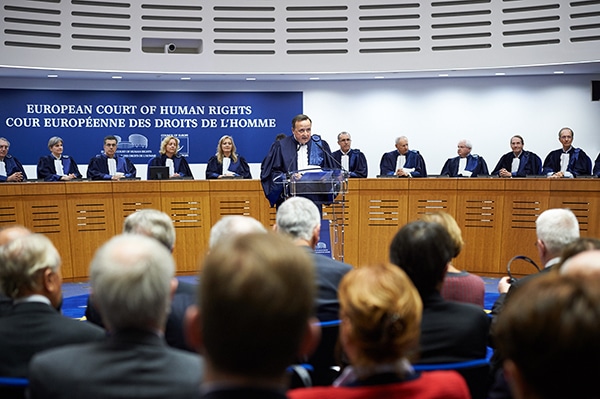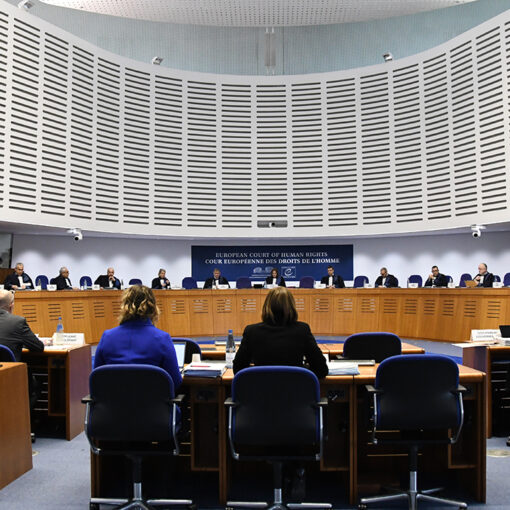A key and underrated aspect of the recent triad of climate rulings of the European Court of Human Rights (ECtHR) is that the ECtHR has brought to the fore the role of trade-related greenhouse gas (GHG) emissions in states’ carbon footprints. While most international climate agreements focus on the reduction of domestic GHG emissions, in the Verein KlimaSeniorinnen Schweiz and Others v. Switzerland Judgment (KlimaSeniorinnen), the ECtHR found ‘attributable’ to Switzerland the GHG emissions taking place abroad, ‘embedded’ into goods (and possibly services) ‘consumed’ in Switzerland. As I will argue, the ruling all but requires Switzerland to adopt a climate-oriented trade policy.
I begin by examining the notion of ‘embedded emissions’ in trade and how KlimaSeniorinnen establishes that parties to the European Convention on Human Rights (ECHR) are responsible not only for produced emissions but also for consumed ones. I then consider what compliance with the underlying demands might entail and how it can be achieved in light of Switzerland’s commitments under the World Trade Organization (WTO) and other trade agreements. Perhaps counter-intuitively for those who follow international trade law from a distance, trade agreements not only permit trade-related climate measures but may boost their operation, by (i) requiring demonstration that measures taken contribute to their stated objective and (ii) prohibiting measures that cosmetically affect some parties while sparing others that equally contribute to the problem.
Embedded Emissions and International Trade
Production is a crucial source of anthropogenic GHGs. Discussion of state action regarding climate change, including in the Paris Agreement, often focuses on industrial and agricultural production within each state. However, in a global economy, goods are routinely traded internationally and, increasingly, produced specifically to meet foreign demand. Thus, many states’ economies and societies contribute to GHG emissions not by themselves producing goods, but by consuming high-emission products produced elsewhere (or producing goods with foreign high-emission inputs), so that the bulk of a state’s contribution may be due to production outside that state’s borders whose emissions are ‘embedded’ in traded goods.
This is particularly true for advanced economies, like Switzerland, which focus on producing low-emissions services and high-end products and import many goods and services associated with high emissions. In KlimaSeniorinnen, the ECtHR noted the general acceptance, including by Swiss authorities, that ‘the GHG emissions attributable to Switzerland through the import of goods and their consumption form a significant part (an estimate of 70% for 2015) of the overall Swiss GHG footprint’ (para. 279).
Two types of issues may arise with respect to embedded emissions. The first is ‘carbon leakage,’ which may occur if a jurisdiction charges for or restricts GHG emissions nationally. In response, production may simply shift to jurisdictions that do not limit emissions. Regardless of individual producers’ decisions, production may shift as consumers worldwide respond to the price increase and purchase the cheaper products produced without emissions restrictions.
Addressing carbon leakage is the stated aim of the European Union’s Carbon Border Adjustment Mechanism (CBAM), which, from 2027, will charge, at the EU border, importers for what the EU determines are the embedded emissions in six categories of products. While the CBAM aims to mirror the EU’s internal carbon pricing mechanism, the ECtHR seems to demand something different from Switzerland: directly addressing the GHG emissions occurring abroad that are ‘attributable’ to Switzerland through its consumption of the relevant products. In effect, then, Switzerland must orient its trade policy towards decarbonization.
A Climate Oriented Trade Policy?
Three elements in KlimaSeniorinnen point to a requirement for Switzerland to orient trade policy towards decarbonization. First, in deciding whether to accept the (late) inclusion of embedded emissions within the scope of the complaint, the ECtHR noted that the proportion of Swiss emissions consumption attributable to imports made it ‘difficult, if not impossible, to discuss Switzerland’s responsibility for the effects of its GHG emissions on the applicants’ rights without considering the emissions generated through the import of goods and their consumption’ (para. 280). Given this proportion, if the complainants had not themselves mentioned embedded emissions in their application and arguments, the ECtHR would have been allowed ‘to clarify, if necessary even of its own motion, these facts’ (para. 280).
Second, the ECtHR rejected the Swiss government’s argument that the Court did not have jurisdiction over embedded emissions and ‘GHG emissions generated abroad could not be considered to attract the responsibility of Switzerland’, since Swiss authorities ‘did not have direct control over the sources of emissions’ (para. 285).
The ECtHR disagreed. The claim regarding embedded emissions ‘contain[ed] an extraterritorial aspect,’ the Court reasoned, but the relevant basis for its jurisdiction was ECHR Article 1, which requires parties to ‘secure to everyone within their jurisdiction the rights and freedoms’ guaranteed in the Convention. The extraterritorial step between state action and effects on applicants’ Convention rights, the Court ruled, did not prevent jurisdiction; it could only be relevant in assessing Switzerland’s responsibility for the effects caused by the extraterritorial event on the applicants’ ECHR rights (para. 287). Put more broadly, the ECHR party’s responsibility is to prevent harms to Convention rights and freedoms of those within their jurisdiction. If the immediate cause of the harm to ECHR rights and freedoms are GHG emissions taking place abroad to meet an ECHR party’s demand for goods (and possibly services), failure to address these embedded emissions may engage that state’s responsibility under the Convention.
Finally, the Court established, albeit indirectly, an obligation, at least for a state in Switzerland’s position, to act with respect to embedded emissions. The ECtHR’s main assertion was that parties to the ECHR have a duty to ‘undertake measures for the substantial and progressive reduction of their respective GHG emission levels, with a view to reaching net neutrality within, in principle, the next three decades’ [548]. The Court described this duty as follows:
the State’s primary duty is to adopt, and to effectively apply in practice, regulations and measures capable of mitigating the existing and potentially irreversible, future effects of climate change. … the Contracting States need to put in place the necessary regulations and measures aimed at preventing an increase in GHG concentrations in the Earth’s atmosphere and a rise in global average temperature beyond levels capable of producing serious and irreversible adverse effects on human rights. [546]
This description provides little clarity as to the content of the regulations and measures to be adopted by Contracting States. At the same time, the Court found that, for ECHR parties, merely addressing domestic emissions is insufficient to comply with their Convention obligations. Although global aims formulated, among others, in the Paris Agreement, must ‘inform the formulation of domestic policies,’ the ECtHR found that ‘the positive obligations relating to the setting up of a regulatory framework must be geared to the specific features of the subject matter and the risks involved’. Global aims ‘cannot of themselves suffice as a criterion for any assessment of Convention compliance’. Instead, ‘each individual State is called upon to define its own adequate pathway for reaching carbon neutrality, depending on the sources and levels of emissions and all other relevant factors within its jurisdiction’ (para. 547).
These findings seem designed to be read in light of the Court’s assertion that there are ‘GHG emissions attributable to Switzerland through the import of goods’ (para. 279) and that it would be ‘difficult, if not impossible, to discuss Switzerland’s responsibility for the effects of its GHG emissions on the applicants’ rights without taking into account the emissions generated through the import of goods and their consumption’ (para. 280). It would seem that – besides and beyond specific treaty obligations – an ECHR party such as Switzerland, whose contribution to global GHG emissions is largely attributable to its imports, would, in its path towards carbon neutrality, be required to act upon a key source of its contribution, i.e., imports.
The Court is vague regarding the specific policies that must be adopted. One possibility is that Switzerland could adopt a similar, if not identical, measure to the EU’s CBAM, imposing a charge on imported products for their asserted carbon content. An alternative possibility would be to require imports with potentially high levels of embedded emissions to be credibly certified as produced with a lower carbon footprint. A more extreme possibility would be to prohibit certain imports entirely.
Climate Obligations, Action on Embedded Emissions, and Trade Agreements – Considering the Real Challenges
Fulfilling ECHR obligations, as interpreted by the ECtHR in KlimaSeniorinnen, may require imposing constraints on imports to address their embedded emissions. This raises the traditional question of a possible conflict between trade obligations and human rights or environmental obligations. Luckily, over the past two decades, international trade adjudicators have largely consolidated the understanding that this is a false conflict (for this, see here and here).
It is a false conflict not only in the sense that states can comply with their trade obligations while complying with their human rights and environmental obligations – an abstract-sounding claim that human rights and environmental activists see with understandable suspicion. It is false also in the sense that, under their contemporary interpretation, trade commitments fundamentally operate in favour of the fulfilment, by trade-related environmental measures, of their environmental objectives.
Setting aside the maze of commitments, defences and exceptions in trade agreements, their contemporary interpretation plainly permits the restriction of trade to fulfil legitimate objectives. This permission has two conditions. First, the measure must indeed make a contribution to the fulfilment of its stated objective. Second, the measure must have a non-discriminatory application: any negative impact that they produce on a trade partner’s exports, as compared to domestic production and third-country exports, must also be justifiable under a legitimate objective. In other words, in imposing import restrictions to address GHG emissions and comply with ECHR obligations, Switzerland must choose restrictions that (i) actually contribute, demonstrably or credibly, to a reduction in GHG emissions; and (ii) are ‘even-handed’ in that they operate to restrict domestic production, and the production of all other trade partners, in light of the same objective. This was recently reaffirmed by the WTO panel report in EU – Palm Oil, which stated – for the first time unequivocally – that climate change, a phenomenon ‘inherently global in nature,’ affects each WTO Member’s territory, allowing every Member to adopt genuine and non-discriminatory trade-related climate measures [para. 7.314].
There is therefore little scope for questioning whether Switzerland can adopt trade-related climate measures. The thorny questions will relate to the means it can employ, in particular so as to avoid charges of discrimination (which can get complicated). I conclude this post with four challenges that may arise if Switzerland (and/or other ECHR parties) seeks to impose trade-related climate measures:
- Non-discrimination is simplest with regard to ‘apples-to-apples’ comparisons. For example, the emissions price charged from, say, Indian steel, cannot be higher than the price charged for Swiss or German steel emissions. A more challenging question will occur if, like CBAM, Swiss measures target some products but not others. Can a measure be discriminatory due to the selection of products it targets, if it heavily affects imports while leaving intact products, with similar levels of emissions, largely produced domestically?
- Can Switzerland adopt an emissions charge while banding with the EU and others to form a ‘climate club’, exempting each other from charges owing to the adoption of similar domestic systems for emissions pricing? Can this ‘climate club’ include parties like the United States, whose decarbonization measures are non-financial, while leaving out others? For more on this question, see here.
- What role is there for the principle of common but differentiated responsibilities and respective capabilities in the assessment of discrimination? The ECtHR noted that this principle undergirds treaties that are central to the climate regime (para. 442). Does this principle allow ECHR parties to differentiate in favour of certain states, or perhaps require this differentiation? Can such differentiation be justified before a trade adjudicator? And can the absence of differentiation violate trade commitments?
- The climate regime has moved from requiring specific measures under the Kyoto Protocol to allowing each state to establish its Nationally Determined Contributions (NDCs) under the Paris Agreement. Does imposing restrictions on specific imported products, linked to their embedded emissions, deny Paris Agreement parties the right to establish their own NDCs and the means to achieve them?
It was uncontroversial in this case that 70% of the overall Swiss GHG footprint is connected to imports. If Switzerland has an obligation to reduce its footprint to attain carbon neutrality, it is hard to see how this obligation may be fulfilled without affecting emissions embedded in imported products (and perhaps, even more challengingly, services). The KlimaSeniorinnen judgment thus would seem to require Switzerland, and presumably other similarly situated ECHR parties, to adopt trade-related climate measures to reduce their carbon footprint arising from consumption.
This requirement is likely to face resistance from the countries where the emissions are produced, grounded not only on charges of discrimination but also on charges of extraterritorial regulation. The charge is likely to be all the stronger when it comes from former European colonies and countries that, not having been responsible for significant levels of emissions until very recently, perceive decarbonization requirements as an instrument for ‘kicking away the ladder’ of development-through-emissions used by all currently developed countries.
Negotiating between heeding legitimate demands for development, on the one hand, and preventing individual states’ development strategies from leading to an uninhabitable planet, on the other, is possibly the most challenging collective action problem humanity has faced so far. The KlimaSeniorinnen Judgment lays down an important piece of this puzzle, first by refusing to accept that externalizing emissions exempts states from their obligation to work towards emissions reduction, and second by clarifying that this obligation must be performed, among others, by addressing embedded emissions. The other international courts expected to weigh in on international climate-related obligations this year would do well to consider providing further guidance in this regard.

Geraldo Vidigal
Geraldo Vidigal is Assistant Professor at the University of Amsterdam (UvA).






